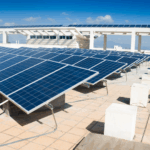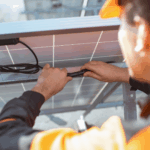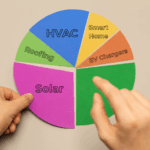Homeowners choose solar power for energy cost savings, to reduce their carbon footprint, and to bring energy stability to their homes. What’s often overlooked is the increase in home value that solar power brings.
If a homeowner thinks they may move at some point in the next 30 years, the price increase they get from their solar equipment is a financial consideration that can’t be overlooked. Sales reps often shy away from talking about home value because the concept can be a bit abstract.
Those who mention home value increases have been long quoting a study that Zillow did in 2019. In this study, Zillow concluded that homes with solar energy sold for 4.1% more on average than comparable homes without solar.
Given time and increased deployment of solar in the US, how do those numbers look in 2025?
Table of Contents
Research Data & Methodology
To accurately assess the scale of the U.S. solar market, we required a large sample size. According to SEIA, the market surpassed 5 million solar-powered homes as of 2024. We concentrated on California, which accounted for 1.8 million of these homes– 36% of all solar installations in the U.S.
Our study analyzed 5,000 California homes sold between 2020-2023, focusing on single-family residences in major cities. The dataset included:
- 2,350 homes with owned solar PV systems
- 1,790 homes with third-party-owned solar (leases/PPAs)
- 860 homes without any solar installed

To compare prices fairly, we matched each solar home with three non-solar homes nearby that were of similar size and age and had similar amenities. To account for market changes over the years, we utilized the Case-Shiller Home Price.
Key Findings – How Much Does Home Value Increase From Solar?
Overall, our research showed that homes with owned solar panels sold for 5-10% more than comparable homes without solar panels.
Homes with leased (third-party-owned) solar panels didn’t sell for more than their comparable counterparts. Even though owners saved on energy bills, the prices were roughly the same as those without solar.

The age of the solar equipment factored into the price increase slightly. Systems over five years old sold for 5-6% more, while newer systems sold for 7-9% more. While there is a slight advantage to newer technology, it’s clear that homeowners value long-term savings above all.
This means a typical California home costing $750,000 could sell for $37,500 – $75,000 more.
Further substantiating our findings, Solar Reviews did their own study in mid-2024 that looked to replicate the 2019 Zillow study.
In their study, the Solar Reviews team looked at over 400 homes with and without solar across the United States. They found that homes with solar sold for an average of 6.8% more than comparable homes without solar. They note that while the housing market has ebbed and flowed since 2020, solar consistently added value to homes.
Value Drivers for Owning Solar
Several factors make homes with solar panels more valuable:
Cost Savings – Buyers recognize and are willing to pay a premium for the 25+ years of projected utility bill savings solar provides. This adds up to significant amounts over the system’s lifetime.
Energy Stability—In markets with unstable grids and prices, solar brought peace of mind to homeowners. As battery adoption continues to grow, including batteries will provide security.
High-Quality Build – Installing solar panels shows a home has been improved for the long term.
Financial Incentives – While owners of second-hand solar systems won’t benefit from tax incentives, original owners can recoup their investment quickly. Buying a house with solar panels brings new owners energy savings without the upfront investment.
Increasing Awareness – As more homes go solar, the market values this investment more.
Limitations of Third-Party-Owned Solar
As our study found, homes with third-party-owned solar systems did not benefit from increases in their value. Some of the reasons for this might include:
No Asset Ownership – Since the homeowner has no equity stake, no tangible asset or infrastructure improvement is reflected in the home’s market value.
Unclear Cost Savings – Solar leases often have complex pricing that can provide limited cost savings and even escalate costs over time, negating this value driver.
Contract Obligations – Transferring leases/PPAs to new owners is a hassle that can scare away some buyers and complicate or devalue transactions.
Inability to Capture Incentives – Third-party owners, not homeowners, capture most of the benefits of solar rebates and tax credits.
Using This To Your Advantage in a Sale
The research studies above show that owning solar panels is an incredible choice for increasing home value, on par with some of the other most commonly invested-in home value upgrades.
When speaking with a homeowner and converting the value your solar array will provide, it’s important to talk about the long-term plans of that homeowner. If they are considering moving sometime in the future, doing a short calculation with them to show the value increase can have a drastic impact.
From a return on investment standpoint, value increases can’t be ignored. The average size of a solar installation in the US is 7.4 kW; at $3/W, a customer would spend just over $22,000 on their installation. If the home is valued over $310,000, the homeowner would recoup more than the cost to install their panels once they solar.
That and the energy savings make owning solar a no-brainer investment for a home.



